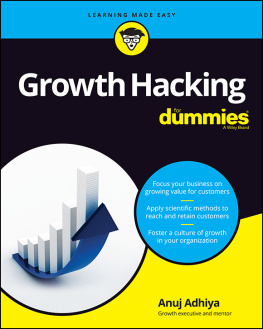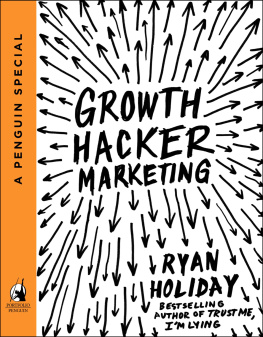Sean Ellis - Hacking Growth: How Today’s Fastest-Growing Companies Drive Breakout Success
Here you can read online Sean Ellis - Hacking Growth: How Today’s Fastest-Growing Companies Drive Breakout Success full text of the book (entire story) in english for free. Download pdf and epub, get meaning, cover and reviews about this ebook. year: 2017, publisher: Crown Business, genre: Business. Description of the work, (preface) as well as reviews are available. Best literature library LitArk.com created for fans of good reading and offers a wide selection of genres:
Romance novel
Science fiction
Adventure
Detective
Science
History
Home and family
Prose
Art
Politics
Computer
Non-fiction
Religion
Business
Children
Humor
Choose a favorite category and find really read worthwhile books. Enjoy immersion in the world of imagination, feel the emotions of the characters or learn something new for yourself, make an fascinating discovery.

- Book:Hacking Growth: How Today’s Fastest-Growing Companies Drive Breakout Success
- Author:
- Publisher:Crown Business
- Genre:
- Year:2017
- Rating:4 / 5
- Favourites:Add to favourites
- Your mark:
Hacking Growth: How Today’s Fastest-Growing Companies Drive Breakout Success: summary, description and annotation
We offer to read an annotation, description, summary or preface (depends on what the author of the book "Hacking Growth: How Today’s Fastest-Growing Companies Drive Breakout Success" wrote himself). If you haven't found the necessary information about the book — write in the comments, we will try to find it.
It seems hard to believe today, but there was a time when Airbnb was the best-kept secret of travel hackers and couch surfers, Pinterest was a niche web site frequented only by bakers and crafters, LinkedIn was an exclusive network for C-suite executives and top-level recruiters, Facebook was MySpaces sorry step-brother, and Uber was a scrappy upstart that didnt stand a chance against the Goliath that was New York City Yellow Cabs.
So how did these companies grow from these humble beginnings into the powerhouses they are today? Contrary to popular belief, they didnt explode to massive worldwide popularity simply by building a great product then crossing their fingers and hoping it would catch on. There was a studied, carefully implemented methodology behind these companies extraordinary rise. That methodology is called Growth Hacking, and its practitioners include not just todays hottest start-ups, but also companies like IBM, Walmart, and Microsoft as well as the millions of entrepreneurs, marketers, managers and executives who make up the community of GrowthHackers.com.
Think of the Growth Hacking methodology as doing for market-share growth what Lean Start-Up did for product development, and Scrum did for productivity. It involves cross-functional teams and rapid-tempo testing and iteration that focuses customers: attaining them, retaining them, engaging them, and motivating them to come back and buy more.
An accessible and practical toolkit that teams and companies in all industries can use to increase their customer base and market share, this book walks readers through the process of creating and executing their own custom-made growth hacking strategy. It is a must read for any marketer, entrepreneur, innovator or manger looking to replace wasteful big bets and spaghetti-on-the-wall approaches with more consistent, replicable, cost-effective, and data-driven results.
Sean Ellis: author's other books
Who wrote Hacking Growth: How Today’s Fastest-Growing Companies Drive Breakout Success? Find out the surname, the name of the author of the book and a list of all author's works by series.







